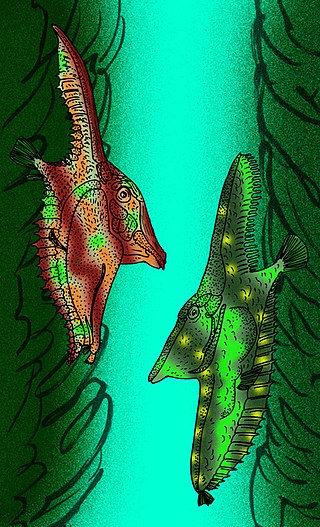
Bananogmius is an extinct genus of ray-finned fish that lived in what is today Kansas during the Late Cretaceous. It lived in the Western Interior Seaway, which split North America in two during the Late Cretaceous. Some species like B. evolutus later reclassified as Pentanogmius.
Asiatoceratodus is an extinct genus of lungfish which lived during the Middle-Late Triassic, Jurassic and Cretaceous periods in what is now Asia (Kyrgyzstan), Africa and South America.

Trewavasia carinata is an extinct pycnodontid fish in the family Coccodontidae that lived during the lower Cenomanian of what is now Lebanon. It had a large, forward-pointing horn-like spine between its eyes, and a massive stump-like spine emanating from the back of its head. T. carinata is closely related the genera Corusichthys and Hensodon, as well as Coccodus.

Paranogmius is an extinct genus of prehistoric bony fish that lived during the Cenomanian. It is known from only 2 partial skulls and several dorsal vertebrae discovered in the Bahariya Formation that was destroyed during World War II. Since then, no more fossils have been discovered. It may have been up to 3 meters long.
Oshunia is an extinct genus of prehistoric bony fish that lived during the Albian. Fossils of the genus were found in the Romualdo Formation of the Araripe Basin, northeastern Brazil. Other authors assign a Cenomanian age to the fish.
Sakamenichthys is an extinct genus of prehistoric bony fish that lived during the Early Triassic epoch in what is now Madagascar. Fossils were recovered from beds of the Middle Sakamena Formation of the Beroroha basin in the southern part of the island.

Retodus is an extinct genus of prehistoric lungfish found in Cretaceous-aged freshwater strata of Egypt, Algeria and Niger. The type species, R. tuberculatus, was named in 2006. It was originally named as a species of Ceratodus and Neoceratodus in 1963.

Acentrophorus is an extinct genus of prehistoric ray-finned fish from the Wuchiapingian of England and Germany (Kupferschiefer). There may also be a Triassic occurrence in Australia.
Ankylophorus is an extinct genus of stem-teleost ray-finned fish that lived in what is now France during the Late Jurassic. Its type and only species, Ankylophorus similis, was originally named in 1895 as a species of Pholidophorus, but was moved to a separate genus in 1978.

Ctenothrissa is a prehistoric genus of ray-finned fish in the supposed order "Ctenothrissiformes".
Luxilites is an extinct genus of prehistoric bony fish.
Martinichthys is an extinct genus of plethodid fish from the Cretaceous of North America. It is known from the Niobrara Chalk, in which it is exceedingly rare. It is named after one H. T. Martin, who collected the most complete specimen at the time of description.

Coccodontidae is a family of extinct pycnodontid fish that lived during the lower Cenomanian. The various genera had massive, curved spines.

Plethodidae is an extinct family of teleost fish that existed during the Late Cretaceous period. Fossils are known from North America, North Africa, and Europe.

Corusichthys megacephalus is an extinct pycnodontid that lived during the lower Cenomanian of what is now Lebanon. C. megacephalus is known from a 34 mm long fossil. It had plates arranged like a helmet around its head, and had a massive, triangular spine on its dorsal side. C. megacephalus is closely related the genera Trewavasia and Hensodon, as well as Coccodus.

Gebrayelichthyidae is a family of extinct pycnodontid fish, with a superficially shrimpfish-like appearance that lived during the lower Cenomanian.

Tselfatiiformes is an extinct order of bony fishes from the infraclass Teleostei. The order represents the most important radiation of marine teleosts during the Cretaceous period. Fossils of tselfatiiforms are known from Europe, North America, central and northern South America, the Middle East and North Africa.

Pentanogmius is an extinct genus of sail-finned ray-finned fish that lived during the Late Cretaceous in what is now Europe and the United States. Five species are currently recognized, 2 from Cenomanian to Turonian Europe and 3 better known species from Coniacian to Campanian North America. The American species inhabited large areas of the Western Interior Seaway, with fossil finds indicating a range from Texas and Alabama in the south to Manitoba, Canada, in the north.
Ptychocorax is an extinct genus of mackerel sharks that lived during the Late Cretaceous. It contains three valid species that have been found in Europe and Asia. It was originally identified as a hybodontiform, but was later reidentified as an anacoracid. It has also been considered to belong to its own family, Ptychocoracidae. Ptychocorax is characterized by its unique dentition, combining Squalicorax-like, cutting anterior teeth with Ptychodus-like, crushing posterior teeth.

Maraldichthys verticalis is a species of pycnodontiform fish of the family Gebrayelichthyidae, the only in the monotypic genus Maraldichthys. It lived during the Cenomanian of Lebanon.



















